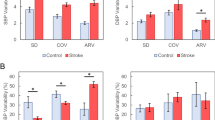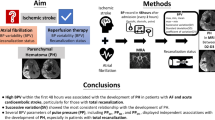Abstract
The relationship of beat-to-beat blood pressure variability (BPV) with prognosis after mechanical thrombectomy (MT) is unclear. Consecutive patients with acute ischemic stroke with large vessel occlusion treated with and without MT matched 1:1 by age, sex, and National Institutes of Health Stroke Scale were included. Beat-to-beat BPV was calculated for both systolic (SBP) and diastolic blood pressure (DBP) as standard deviation, coefficient of variation, successive variation (SV), and average real variability (ARV) at 24–72 h after MT. Additionally, hour-to-hour (first 24 h after MT) and day-by-day BPV (first 7 days after MT) were also measured. The outcome was modified Rankin Scale (mRS) at 3 months. Of 168 patients, 84 patients received MT and 84 did not. MT closely correlated with lower beat-to-beat BPV parameters. Beat-to-beat SBP-SV and SBP-ARV were significantly higher in patients with unfavorable outcome than in those with favorable outcome (median 3.40 vs 2.71; P = 0.016; median 2.81 vs 2.20, P = 0.003). After adjusting for confounders, higher beat-to-beat SBP-SV and SBP-ARV were independently associated with unfavorable outcome in patients with MT (all P < 0.05). However, no association was found between hour-to-hour and day-by-day BPV and outcome at 3 months (P > 0.05). The patients with MT had lower beat-to-beat BPV values in the acute phase, which indicated that MT has a positive effect on beat-to-beat BPV. Furthermore, beat-to-beat BPV, rather than hour-to-hour or day-by-day BPV, is an independent risk factor for unfavorable outcome in patients after MT.

This is a preview of subscription content, access via your institution
Access options
Subscribe to this journal
Receive 12 print issues and online access
$259.00 per year
only $21.58 per issue
Buy this article
- Purchase on SpringerLink
- Instant access to full article PDF
Prices may be subject to local taxes which are calculated during checkout



Similar content being viewed by others
Data availability
The data that support the findings of this study are available from the corresponding author upon reasonable request.
References
Powers WJ, Rabinstein AA, Ackerson T, Adeoye OM, Bambakidis NC, Becker K, et al. Guidelines for the early management of patients with acute ischemic stroke: 2019 update to the 2018 guidelines for the early management of acute ischemic stroke: a guideline for healthcare professionals from the American Heart Association/American Stroke Association. Stroke. 2019;50:e344–e418.
Kuczynski AM, Demchuk AM, Almekhlafi MA. Therapeutic hypothermia: applications in adults with acute ischemic stroke. Brain Circ. 2019;5:43–54.
Parati G, Ochoa JE, Lombardi C, Bilo G. Assessment and management of blood-pressure variability. Nat Rev Cardiol. 2013;10:143–55.
Tang S, Xiong L, Fan Y, Mok VCT, Wong KS, Leung TW. Stroke outcome prediction by blood pressure variability, heart rate variability, and baroreflex sensitivity. Stroke. 2020;51:1317–20.
Bakkar NZ, El-Yazbi AF, Zouein FA, Fares SA. Beat-to-beat blood pressure variability: an early predictor of disease and cardiovascular risk. J Hypertens. 2021;39:830–45.
Mattle HP, Kappeler L, Arnold M, Fischer U, Nedeltchev K, Remonda L, et al. Blood pressure and vessel recanalization in the first hours after ischemic stroke. Stroke. 2005;36:264–8.
He GY, Li YH, Wei JJ, Xiao JD, Chen Y, Fan BL, et al. Effect of perioperative blood pressure variability on cerebral hyperperfusion syndrome after carotid artery stenting: a retrospective study. Interv Neuroradiol. 2021;28:702–7.
Higashida RT, Furlan AJ, Roberts H, Tomsick T, Connors B, Barr J, et al. Trial design and reporting standards for intra-arterial cerebral thrombolysis for acute ischemic stroke. Stroke. 2003;34:e109–37.
WANG Zengwu; Beijing Hypertension Association; Chinese Stroke Association Hypertension Prevention and Management Branch;National Center for Cardiovascular Diseases FH, Chinese Academy of Medical Sciences. Chinese expert consensus on hypertension management in stroke patients. Chin J Stroke. 2024;19:672–98.
Qu Y, Guo Z-N, Zhang P, Ma H-Y, Sun Y-Y, Ren J-X, et al. Time course of beat-to-beat blood pressure variability and outcome in patients with spontaneous intracerebral haemorrhage. J Hypertens. 2022;40:1744–50.
Guo ZN, Qu Y, Reziya H, Liu J, Yan XL, Zhang P, et al. Which parameters of beat-to-beat blood pressure best predict poor in-hospital outcome in spontaneous intracerebral hemorrhage? Front Aging Neurosci. 2020;12:603340.
Parati G, Saul JP, Di Rienzo M, Mancia G. Spectral analysis of blood pressure and heart rate variability in evaluating cardiovascular regulation. A critical appraisal. Hypertension. 1995;25:1276–86.
Murakami S, Otsuka K, Kubo Y, Shinagawa M, Matsuoka O, Yamanaka T, et al. Weekly variation of home and ambulatory blood pressure and relation between arterial stiffness and blood pressure measurements in community-dwelling hypertensives. Clin Exp Hypertens. 2005;27:231–9.
Webb AJS, Mazzucco S, Li L, Rothwell PM. Prognostic significance of blood pressure variability on beat-to-beat monitoring after transient ischemic attack and stroke. Stroke. 2018;49:62–7.
Mistry EA, Mehta T, Mistry A, Arora N, Starosciak AK, De Los Rios La Rosa F, et al. Blood pressure variability and neurologic outcome after endovascular thrombectomy: a secondary analysis of the BEST study. Stroke. 2020;51:511–8.
Huang X, Guo H, Yuan L, Cai Q, Zhang M, Zhang Y, et al. Blood pressure variability and outcomes after mechanical thrombectomy based on the recanalization and collateral status. Ther Adv Neurol Disord. 2021;14:1756286421997383.
Kim TJ, Park HK, Kim JM, Lee JS, Park SH, Jeong HB, et al. Blood pressure variability and hemorrhagic transformation in patients with successful recanalization after endovascular recanalization therapy: a retrospective observational study. Ann Neurol. 2019;85:574–81.
Castro P, Ferreira F, Nguyen CK, Payabvash S, Ozan Tan C, Sorond F, et al. Rapid assessment of blood pressure variability and outcome after successful thrombectomy. Stroke. 2021;52:e531–e5.
Cui Y, Ning YX, Cai JR, Zhang NN, Chen HS. Association of systolic blood pressure variability with remote ischemic conditioning in acute ischemic stroke. Sci Rep. 2024;14:15562.
Rothwell PM, Howard SC, Dolan E, O’Brien E, Dobson JE, Dahlof B, et al. Effects of beta blockers and calcium-channel blockers on within-individual variability in blood pressure and risk of stroke. Lancet Neurol. 2010;9:469–80.
Castro P, Azevedo E, Sorond F. Cerebral autoregulation in stroke. Curr Atheroscler Rep. 2018;20:37.
Manning LS, Rothwell PM, Potter JF, Robinson TG. Prognostic significance of short-term blood pressure variability in acute stroke: systematic review. Stroke. 2015;46:2482–90.
Yong M, Diener HC, Kaste M, Mau J. Characteristics of blood pressure profiles as predictors of long-term outcome after acute ischemic stroke. Stroke. 2005;36:2619–25.
Buratti L, Cagnetti C, Balucani C, Viticchi G, Falsetti L, Luzzi S, et al. Blood pressure variability and stroke outcome in patients with internal carotid artery occlusion. J Neurol Sci. 2014;339:164–8.
Webb AJS, Lawson A, Wartolowska K, Mazzucco S, Rothwell PM. Progression of beat-to-beat blood pressure variability despite best medical management. Hypertension. 2021;77:193–201.
Lee YK, Mazzucco S, Rothwell PM, Payne SJ, Webb AJS. Blood pressure complexity discriminates pathological beat-to-beat variability as a marker of vascular aging. J Am Heart Assoc. 2022;11:e022865.
Tian G, Xiong L, Leung H, Soo Y, Leung T, Wong LK. Beat-to-beat blood pressure variability and heart rate variability in relation to autonomic dysregulation in patients with acute mild-moderate ischemic stroke. J Clin Neurosci. 2019;64:187–93.
Chang JY, Jeon SB, Lee JH, Kwon OK, Han MK. The relationship between blood pressure variability, recanalization degree, and clinical outcome in large vessel occlusive stroke after an intra-arterial thrombectomy. Cerebrovasc Dis. 2018;46:279–86.
Divani AA, Liu X, Di Napoli M, Lattanzi S, Ziai W, James ML, et al. Blood pressure variability predicts poor in-hospital outcome in spontaneous intracerebral hemorrhage. Stroke. 2019;50:2023–9.
Men X, Sun W, Fan F, Zhao M, Huang X, Wang Y, et al. China Stroke Primary Prevention Trial: Visit‐to‐Visit Systolic Blood Pressure Variability Is an Independent Predictor of Primary Stroke in Hypertensive Patients. JAHA. 2017;6:e004350.
Bennett AE, Wilder MJ, McNally JS, Wold JJ, Stoddard GJ, Majersik JJ, et al. Increased blood pressure variability after endovascular thrombectomy for acute stroke is associated with worse clinical outcome. J Neurointerv Surg. 2018;10:823–7.
Zhao J, Yuan F, Fu F, Liu Y, Xue C, Wang K, et al. Blood pressure variability and outcome in acute severe stroke: a post hoc analysis of CHASE–a randomized controlled trial. J Clin Hypertens. 2021;23:96–102.
Hansen TW, Thijs L, Li Y, Boggia J, Kikuya M, Bjorklund-Bodegard K, et al. Prognostic value of reading-to-reading blood pressure variability over 24 h in 8938 subjects from 11 populations. Hypertension. 2010;55:1049–57.
Zhou TL, Kroon AA, van Sloten TT, van Boxtel MPJ, Verhey FRJ, Schram MT, et al. Greater blood pressure variability is associated with lower cognitive performance. Hypertension. 2019;73:803–11.
Acknowledgements
We thank the patients and their families and appreciate the study participants for their assistance in this study.
Funding
This project was supported by the National Natural Science Foundation of China (823B2025) to YYS, the National Natural Science Foundation of China (Grant No. 81971105), the Science and Technology Department of Jilin Province (YDZJ202201ZYTS677), and Norman Bethune Program of Jilin University (2022B02) to ZNG, and the Norman Bethune Health Science Center of Jilin University (2022JBGS03), Science and Technology Department of Jilin Province (YDZJ202302CXJD061, 20220303002SF), and Jilin Provincial Key Laboratory (YDZJ202302CXJD017) to YY, and Graduate Innovation Fund of Jilin University (2023CX113) to YQ.
Author information
Authors and Affiliations
Contributions
All authors fulfill the criteria for authorship set by the International Committee of Medical Journal Editors. YY and ZNG were responsible for conceptualization. Y-YS, S-YP, YQ, and S-JW performed data collection. Y-YS, H-JZ, YQ, and W-JY performed data analysis and interpretation. The first draft of the manuscript was written by Y-YS and all authors contributed to the article and approved the submitted version.
Corresponding authors
Ethics declarations
Conflict of interest
The authors declare no competing interests.
Ethical approval and consent to participate
The study was conducted according to the principles of the Declaration of Helsinki. Written informed consent for this study was obtained from all study participants or their direct relatives, which was approved by the Ethics Committee of the First Hospital of Jilin University (2016-294).
Consent for publication
All participants consent to publish.
Additional information
Publisher’s note Springer Nature remains neutral with regard to jurisdictional claims in published maps and institutional affiliations.
Supplementary information
Rights and permissions
Springer Nature or its licensor (e.g. a society or other partner) holds exclusive rights to this article under a publishing agreement with the author(s) or other rightsholder(s); author self-archiving of the accepted manuscript version of this article is solely governed by the terms of such publishing agreement and applicable law.
About this article
Cite this article
Sun, YY., Pang, SY., Qu, Y. et al. Prognostic value of beat-to-beat blood pressure variability parameters in patients after mechanical thrombectomy. Hypertens Res 48, 1155–1162 (2025). https://doi.org/10.1038/s41440-024-02060-4
Received:
Revised:
Accepted:
Published:
Issue date:
DOI: https://doi.org/10.1038/s41440-024-02060-4



